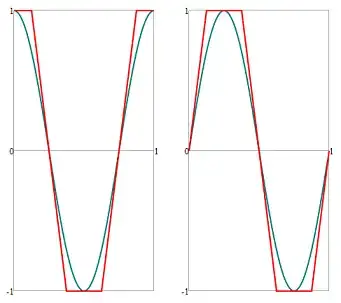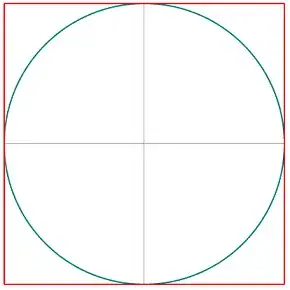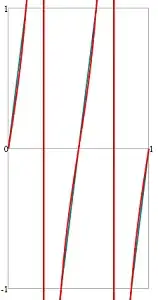It's an easy exercise to approximate the cosine and the sine function by a piecewise linear function on the unit interval $[0,1]$. Let $\tau = 2\pi$.
Let
$$\boxed{\cos_\bigcirc(x) = \cos(\tau x)\\\sin_\bigcirc(x) = \sin(\tau x)}$$
and compare this to
$$\boxed{\cos_\square(x) = \begin{cases} +1 & \text{ for } \frac{0}{8} \leq x \leq \frac{1}{8} \\ +2 - 8x & \text{ for } \frac{1}{8} \leq x \leq \frac{3}{8} \\ -1 & \text{ for } \frac{3}{8} \leq x \leq \frac{5}{8} \\ -6 + 8x & \text{ for } \frac{5}{8} \leq x \leq \frac{7}{8} \\ +1 & \text{ for } \frac{7}{8} \leq x \leq \frac{8}{8} \\ \end{cases} \\ \\\sin_\square(x) = \begin{cases} +0 + 8x & \text{ for } \frac{0}{8} \leq x \leq \frac{1}{8} \\ +1 & \text{ for } \frac{1}{8} \leq x \leq \frac{3}{8} \\ +4 - 8x & \text{ for } \frac{3}{8} \leq x \leq \frac{5}{8} \\ -1 & \text{ for } \frac{5}{8} \leq x \leq \frac{7}{8} \\ -8 + 8x & \text{ for } \frac{7}{8} \leq x \leq \frac{8}{8} \\ \end{cases}}$$
These are the plots:
Observations
- It may come as a surprise or not that while $\cos_\bigcirc(x)$ and $\sin_\bigcirc(x)$ yield the unit circle by $x_\bigcirc(x) = \cos_\bigcirc(x)$ and $y_\bigcirc(x) = \sin_\bigcirc(x)$, the functions $\cos_\square(x)$ and $\sin_\square(x)$ yield the unit square by $x_\square(x) = \cos_\square(x)$ and $y_\square(x) = \sin_\square(x)$. By "unit square" I mean the square with "radius" $1$, not with side length $1$. The unit circle in the incircle of this square:
- While the circumference of the unit circle is just the "number of the circle" $\tau$, the circumference of the unit square is $8$ (the "number of the square"). Note how $8$ is used in the definition of $\cos_\square(x)$ and $\sin_\square(x)$, compared to $\tau$ in the definition of $\cos_\bigcirc(x)$ and $\sin_\bigcirc(x)$. Note further that not by accident $8 \approx \tau$ and that not by accident $8 = 3^2 - 1^2$:
There are natural generalizations of piecewise linear approximations of the cosine and the sine for arbitrary regular $n$-polygons which will approximate the true functions better and better as the polygons will approximate the circle better and better.
The tangens $\tan_\bigcirc(x) = \tan(\tau x)$ is very well approximated already by $\tan_\square(x) = \frac{\sin_\square(x)}{\cos_\square(x)}$:
- The functions $\cos_\square(x)$ and $\sin_\square(x)$ can be used to parametrize the square spiral analoguous to how $\cos_\bigcirc(x)$ and $\sin_\bigcirc(x)$ can be used to parametrize the Archimedean spiral.
Questions
- Under which name and in which contexts have the functions $\cos_\square(x)$ and $\sin_\square(x)$ been studied before?
- Is there an elegant and/or more compact way to write the equations for $\cos_\square(x)$ and $\sin_\square(x)$ in one closed expression, e.g. by using the Heaviside function?
- Is there a closed formula for the Fourier transform of $\cos_\square(x)$ and $\sin_\square(x)$ (the "Fourier transform of the quadrature of the circle")?
This is how the Fourier transforms of $\cos_\square(x)$ and $\sin_\square(x)$ look like:

Summary
Thanks to user J.M. we now know the Fourier coefficients $\widehat{\cos}_\square(k)$
$$\boxed{\widehat{\cos}_\square(k) = 8 \cdot \begin{cases} \ \ \ \ \ 0 & \text{ for } k \equiv 0 \mod 2 \\ +(\pi k)^{-2} & \text{ for } k \equiv 1 \mod 8 \text{ or } k \equiv 7 \mod 8\\ -(\pi k)^{-2} & \text{ for } k \equiv 3 \mod 8 \text{ or } k \equiv 5 \mod 8\\ \end{cases}}$$
and $\widehat{\sin}_\square(k)$ accordingly.
Now can perform the squaring of the circle by these steps:
Consider $\cos_\bigcirc(x)$ and $\sin_\bigcirc(x)$ which "draw" the unit circle (with diameter $2$).
Consider the functions $\cos_\square(x)$ and $\sin_\square(x)$ defined by
$$\cos_\square(x) := \sum_{k=0}^{\infty} \widehat{\cos}_\square(k)\cos_\bigcirc(kx)\\ \sin_\square(x) := \sum_{k=0}^{\infty} \widehat{\sin}_\square(k)\sin_\bigcirc(kx)$$
- The functions $\cos_\square(x)$ and $\sin_\square(x)$ "draw" the unit square (with diameter $2$).




